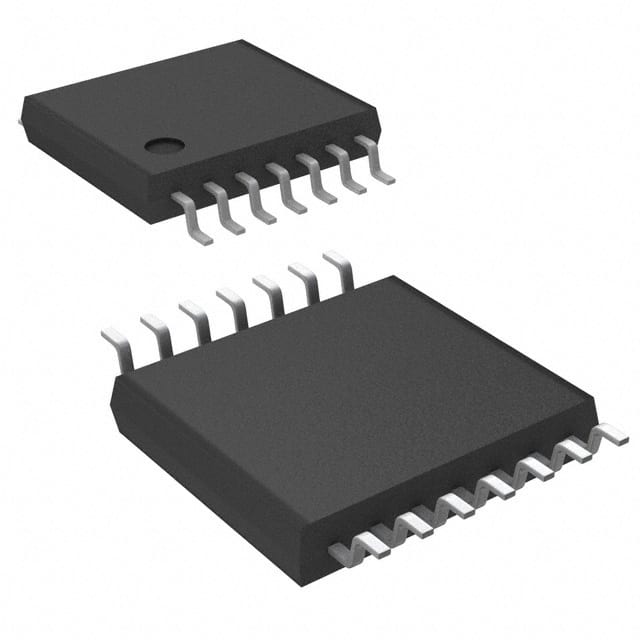Xem thông số kỹ thuật để biết chi tiết sản phẩm.

Encyclopedia Entry: 74VHCT04ATTR
Product Overview
Category
The 74VHCT04ATTR belongs to the category of integrated circuits (ICs). Specifically, it falls under the category of logic gates.
Use
This product is primarily used for signal processing and logical operations in electronic circuits. It serves as an inverter gate, which means it can invert the input signal to produce the complementary output signal.
Characteristics
- High-speed operation: The 74VHCT04ATTR is designed to operate at high speeds, making it suitable for applications that require quick signal processing.
- Low power consumption: This IC is known for its low power consumption, making it energy-efficient and suitable for battery-powered devices.
- Wide voltage range: It can operate within a wide voltage range, typically between 2V and 5.5V, allowing for compatibility with various systems.
- High noise immunity: The 74VHCT04ATTR has excellent noise immunity, ensuring reliable operation even in noisy environments.
Package and Quantity
The 74VHCT04ATTR is commonly available in a small outline integrated circuit (SOIC) package. It consists of 14 pins arranged in a compact form factor. Typically, this IC is sold in reels or tubes containing multiple units.
Specifications
- Supply Voltage Range: 2V to 5.5V
- Input Voltage Range: 0V to Vcc
- Output Voltage Range: 0V to Vcc
- Operating Temperature Range: -40°C to +85°C
- Propagation Delay Time: <10 ns
- Maximum Quiescent Current: 1µA
Pin Configuration
The 74VHCT04ATTR features 14 pins, each serving a specific function. Here is the detailed pin configuration:
Pin 1: Input A
Pin 2: Output A
Pin 3: Ground (GND)
Pin 4: Input B
Pin 5: Output B
Pin 6: Vcc (Positive Power Supply)
Pin 7: Input C
Pin 8: Output C
Pin 9: Input D
Pin 10: Output D
Pin 11: Input E
Pin 12: Output E
Pin 13: Input F
Pin 14: Output F
Functional Features
- Inverting Logic: The 74VHCT04ATTR performs the logical NOT operation, where the output is the inverse of the input signal.
- High-Speed Operation: This IC can process signals at a high speed, making it suitable for time-critical applications.
- Multiple Inputs: It supports multiple input channels, allowing for versatile logic operations.
Advantages and Disadvantages
Advantages
- High-speed operation enables quick signal processing.
- Low power consumption makes it energy-efficient.
- Wide voltage range ensures compatibility with various systems.
- Excellent noise immunity ensures reliable operation in noisy environments.
Disadvantages
- Limited functionality: The 74VHCT04ATTR is an inverter gate and cannot perform other logic operations without additional circuitry.
- Not suitable for high-voltage applications: It operates within a limited voltage range, which may not be suitable for high-voltage systems.
Working Principles
The 74VHCT04ATTR utilizes complementary metal-oxide-semiconductor (CMOS) technology to achieve its logic functions. It consists of transistors that are arranged in a specific configuration to create the inverting logic operation. When an input signal is applied, the internal circuitry processes it and produces the inverted output signal.
Application Field Plans
The 74VHCT04ATTR finds applications in various electronic systems, including: 1. Digital logic circuits 2. Microcontrollers and microprocessors 3. Communication systems 4. Consumer electronics 5. Automotive electronics
Alternative Models
There are several alternative models available that offer similar functionality to the 74VHCT04ATTR. Some popular alternatives include: - 74HC04: This is a standard CMOS inverter gate with similar characteristics. - SN74LS04: A TTL (transistor-transistor logic) inverter gate that can be used as an alternative. - CD4069UB: A hex inverter IC that provides six individual inverters.
These alternative models can be considered based on specific requirements and compatibility with the target system.
In conclusion, the 74VHCT04ATTR is a high-speed, low-power inverter gate IC commonly used in digital logic circuits and various electronic systems. Its wide voltage range, excellent noise immunity, and compact package make it a versatile choice for signal processing applications.
Liệt kê 10 câu hỏi và câu trả lời thường gặp liên quan đến ứng dụng 74VHCT04ATTR trong giải pháp kỹ thuật
Sure! Here are 10 common questions and answers related to the application of 74VHCT04ATTR in technical solutions:
Q: What is the 74VHCT04ATTR? A: The 74VHCT04ATTR is a hex inverter IC (integrated circuit) that consists of six independent inverters.
Q: What is the voltage range supported by the 74VHCT04ATTR? A: The 74VHCT04ATTR supports a voltage range of 2.0V to 5.5V.
Q: What is the maximum operating frequency of the 74VHCT04ATTR? A: The maximum operating frequency of the 74VHCT04ATTR is typically around 200MHz.
Q: Can the 74VHCT04ATTR be used for level shifting applications? A: Yes, the 74VHCT04ATTR can be used for level shifting as it supports both TTL (Transistor-Transistor Logic) and CMOS (Complementary Metal-Oxide-Semiconductor) logic levels.
Q: How many pins does the 74VHCT04ATTR have? A: The 74VHCT04ATTR has 14 pins in total.
Q: What is the power supply voltage required for the 74VHCT04ATTR? A: The power supply voltage required for the 74VHCT04ATTR is typically 5V.
Q: Can the 74VHCT04ATTR be used in high-speed digital applications? A: Yes, the 74VHCT04ATTR is suitable for high-speed digital applications due to its fast propagation delay and low power consumption.
Q: Is the 74VHCT04ATTR compatible with other logic families? A: Yes, the 74VHCT04ATTR is compatible with a wide range of logic families, including TTL, CMOS, and LVTTL (Low-Voltage TTL).
Q: Can the 74VHCT04ATTR be used in both commercial and industrial applications? A: Yes, the 74VHCT04ATTR is suitable for both commercial and industrial applications as it meets the required specifications for these environments.
Q: What are some common applications of the 74VHCT04ATTR? A: The 74VHCT04ATTR is commonly used in digital systems, such as microcontrollers, data communication devices, computer peripherals, and various other electronic circuits that require signal inversion or level shifting.
Please note that the answers provided here are general and may vary depending on specific requirements and datasheet specifications.

